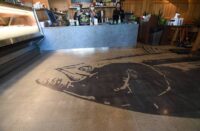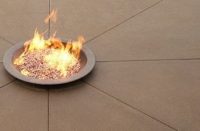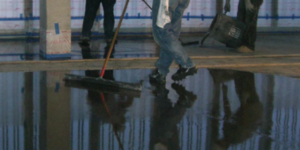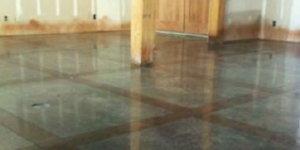
Thin coatings that can be polished work wonders on floors new and old. But applying them right takes know-how.
Polishable overlays are making substantial headway into the realm of decorative concrete. Tom Graf, owner of LifeTime Floors, which manufactures the polymer-modified Artera and the portland cement-based Mosaic toppings, thinks the general state of the economy is one reason why. “Buildings aren’t being built at the rate they were before, so a lot of our business involves what we can do with existing concrete floors. ”
However, contractors take heed: Not everyone is up to the task of properly installing them.
“It’s a field reserved for only the most skilled in the business, ” says Bruce Burton, technical services manager for construction repair systems at Mapei North America, the company behind the polymer-modified Ultratop system. “We get calls from three to four customers a week (about overlays). Fifty percent say we have the best product on the market while the others say they can’t get the job done no matter what they do. ”
Burton says his company also gets mixed reviews from diamond manufacturers. He recalls a time when his company sent material with the same batch code (which identifies the ingredient mix in a given batch) to three manufacturers of diamonds for testing. “One said it was too soft. Another said they got acceptable results but not great. The other said the product was the best thing they ever used. All of which means it’s very complicated. ”
Jim Harvey, creator of Deco-Pour, a portland cement-based overlay, emphasizes patience and education when working with polishable overlays. “You can’t go in and rush through this process, ” he says. “You need to be trained by someone familiar with the product. I think we should only sell to technically competent contractors or we’ll ruin it for everybody. ”

Each brand is unique
David Landrey, director of technical services for Raeco Specialty Cements, defines polishable overlays as “any type of a thin-bonded topping system that’s suitable as a wearable surface for heavy-duty traffic when polished. ” No sealers or waxes are needed. When fully cured, these toppings boast a compressed strength of anywhere between 4,000 and 6,500 psi.
But the generalization stops there. Manufacturers use a wide variety of ingredients to produce these toppings, from portland-based, calcium-aluminate and other fast-setting cements with trace amounts of polymer to complex polymer-modified formulas, some complete with hardeners and others reinforced with fibers. Overlays may be self-leveling or trowelable. They can be applied with or without aggregates or other decorative elements such as glass or metal flakes. Their makeup truly runs the gamut.
“A lot of contractors aren’t familiar with polymer-modified systems, ” says Graf. “They are generally sticky and contractors often get frustrated with them. ” Also, Landrey adds, mixes high in polymer content are not as polishable.
Whatever the overlay is made of, properly prepping the substrate is key to a successful job. It must be free of contaminants, properly profiled and primed. The overlay is generally applied between 3/8 inch and 5/8 inch thick, but it can be put down much thicker if necessary, up to 1 1/2 inches or more.
If a job calls for a thicker application, Graf says, it’s much more cost-effective to use a cement-based topping without polymer modification. “Polymer-modified systems get really, really spendy at anything over 3/4 inch thick. ”
Whether a job is large or small, Landrey says, installing and polishing an overlay generally takes a minimum of four to five days. The polishing process itself involves at least seven steps. The rule of thumb is to wait at least 24 hours before polishing. Some installers prefer to wait longer.
If taken to a full polish, says Graf, both polymer and portland-based systems are breathable, sustainable and can reap LEED points for a project.
Why use a topping?
Probably the most common reason a polishable overlay is installed is to cover an existing substrate that needs serious attention: it’s badly stained, deeply trenched, not level, or has inconsistent aggregate, unsightly patches or ghosting from VTC tiles.
One of an overlay’s most attractive decorative attributes is that colored overlays can be replicated, a feature relished by many big box stores across the nation. “If you can make a sample at the shop, you can reproduce it on the floor, ” says
Joe Zingale, sales representative for CTS Cement Manufacturing Corp., the company that makes the self-leveling, interior/exterior overlayment called Rapid Set TRU.
“If a customer has multiple locations, overlays are easier to duplicate in store after store because they are consistent in makeup, ” he says. In contrast, the shade of regular concrete can vary depending on where a batch’s raw materials came from.
Burton agrees. “With overlays, you can deliver a consistent color and high-quality finish while retaining the natural look and feel of polished concrete, ” he says.
But make no mistake about it. Polishing concrete and polishing concrete overlays are two different animals. Do some research on the toppings you’re considering – call various equipment manufacturers and ask what brands they have worked with, what results they got and what to expect when working with a certain product. “If they say you polish it the same way you’d polish normal concrete, hang up. If they say the overlay systems are quite different than regular concrete, they deserve more questions, ” Burton says. “At the end of the day, pick a manufacturer you trust that has tested the product with a specific hardener, diamonds and equipment. ”
Following manufacturer recommendations and mix instructions, try polishing an overlay in your own basement or garage where you can perfect your technique before you take on a job. “We’ve had contractors who have bid on 20,000 square feet of retail space who have never polished our toppings, ” Burton says. “Way too frequently, it just doesn’t work out. ”

Choosing the right diamonds
Whether overlays have high polymer content or feature hydraulic cement and silica sand, they are all very aggressive on diamonds, says John Abrahamson, manager of East Coast operations and marketing for SASE Co., a company that specializes in surface preparation equipment. “We have special diamonds designed for overlays because they are tricky and react differently. ”
Harvey of Deco-Pour notes that while traditional tools are used to place and polish his portland-based overlay, determining the process took a lot of trial and error. “While the only difference from traditional concrete (polishing) is the size and sequence of the diamonds used, it took us about four years to find the ones to do the job properly. ”
Before tackling a job, contact your diamond supplier, Abrahamson suggests. If asked, most leading companies will direct you to purchase certain diamonds to be used with specific products.
When you use the right diamonds, you’ll get the proper wear and they’ll last longer, he says. “When grinding soft concrete use a hard-bonded diamond, and if the concrete is hard use a soft-bonded diamond. ”
Polishing polymers can get a bit tricky, notes Burton of Mapei. If you start polishing a polymer topping after it has set for only 24 hours, you will be polishing a surface that hasn’t yet reached its cured hardness of 6,000 psi. “Maybe it’s only 2,500 psi at that point, ” he says. “You have to work with it as a soft product. People who are successful know how to read the (topping) and compensate for individual circumstances by adjusting equipment and pads. ”
Burton says that for the purposes of polishing and grinding, it’s best to treat polymer toppings as if they were soft no matter their age. “Ultratop and others would rather dent than cut. ”
Finally, Paul Lundberg, director of sales and operation for VMC Technical Assistance Corp., advises contractors to avoid using metal-bond diamonds when polishing overlays high in polymers. “Metal bonds leave scratches that are difficult to remove, ” he says. If you can, start with a resin-bond diamond or a hybrid diamond, if necessary.
Polishable overlay manufacturers
www.decopour.com
www.lifetimefloors.biz
www.mapei.com/US-EN
www.raecoinc.com
www.rapidset.com (CTS Cement Manufacturing Corp.)
www.sasecompany.com
www.vmctac.com
















